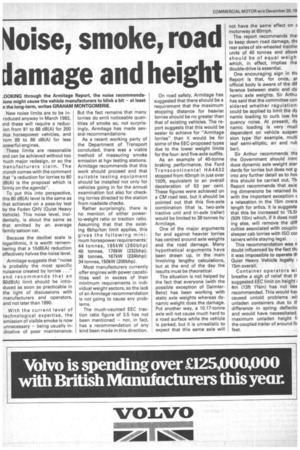4oise, smoke, road damage and height
Page 14

If you've noticed an error in this article please click here to report it so we can fix it.
_OOKING through the Armitage Report, the noise recommendsions might cause the vehicle manufacturers to blink a bit — at least n the long-term, writes GRAHAM MONTGOMERIE.
New noise limits are to be inroduced anyway in March 1983, md these will require a reducion from 91 to 88 dB(A) for 200 )Ius horsepower vehicles, and 'rem 89 to 86 dB(A) for less )owerful engines.
These limits are reasonable )nd can be achieved without too much major redesign, or so the manufacturers claim. The runch comes with the comment :hat "a reduction for lorries to 80 18(A) is the proposal which is firmly on the agenda".
To put this into perspective, this 80 dB(A) level is the same as that achieved on a pass-by test by the Foden QHV (Quiet Heavy Vehicle). This noise level, incidentally, is about the same as that emitted by an average family saloon car.
Because the decibel scale is logarithmic, it is worth remembering that a 10dB(A) reduction effectively halves the noise level.
Armitage suggests that "noise is probably the most specific nuisance created by lorries ..." and recommends that an 80dB(A) limit should be introduced as soon as practicable in the light of discussions with manufacturers and operators, and not later than 1990.
With the current level of technological expertise, the emission of visible smoke is now unnecessary — being usually indicative of poor maintenance. But the fact remains that many lorries do emit noticeable quantities of smoke so, not surprisingly, Armitage has made several recommendations.
As a recent working party of the Department of Transport concluded, there was a viable 'method of measuring smoke emission at hgv testing stations. Armitage recommends that this work should proceed and that suitable testing equipment should be installed not only for vehicles going in for the annual examination but also for checking lorries directed to the station from roadside checks.
Rather surprisingly, there is no mention of either powerto-weight ratio or traction ratio. Assuming that that the existing 6bhp/ton limit applies, this gives the following minimum horsepower requirements: 44 tonnes, 195kW (260 bhp) 40 tonnes, 176kW (232bhp); 38 tonnes, 167kW (224bhp); 34 tonnes, 150kW (200bhp).
Most manufacturers currently offer engines with power capabilities well in excess of their minimum requirements in individual weight sectors, so the lack of an Armitage recommendation is not going to cause any problems.
The much-vaunted EEC traction ratio figure of 3.5 has not been mentioned — nor, in fact, has a recommendation of any kind been made in this direction.
On road safety, Armitage has suggested that there should be a requirement that the maximum stopping distance for heavier lorries should be no greater than that of existing vehicles. The report suggests that this would be easier to achieve for "Armitage lorries" than it would be for some of the EEC-proposed types due to the lower weight limits for the fourand five-axle outfits.
As an example of 40-tonne braking performance, the Ford Transcontinental HA443 2 stopped from 40mph in just over 100ft, equivalent to an overall deceleration of 53 per cent. These figures were achieved on a CM road test, but it should be pointed out that this five-axle combination (that is, two-axle tractive unit and tri-axle trailer) would be limited to 38 tonnes by Armitage.
One of the major arguments for and against heavier lorries has centred around axle weights and the road damage. Many hypothetical arguments have been drawn up, in the main involving lengthy calculations, but at the end of the day the results must be theoretical.
The situation is not helped by the fact that everyone (with the possible exception of DaimlerBenz) has been working with static axle weights whereas dynamic weight does the damage. Put another way, a 10.17-tonne axle will not cause much hard to a road surface while the vehicle is parked, but it is unrealistic to expect that this same axle will
not have the same effect on E motorway at 60mph.
The report recommends thai to keep down road damage, thE rear axles of six-wheeled tractivE units of 40 tonnes and abovE should be of equal weigh which, in effect, implies tha double-drive is essential.
One encouraging sign in thE Report is that, for once, ar official body is aware of the dif ference between static and dy namic axle weights. Sir Arthu has said that the committee con sidered whether regulation: could be applied to limit the dy namic loading to curb low fre quency noise. At present, dy namic loading is very mudl dependent on vehicle suspen sion type (for example, multi leaf semi-elliptic, air and rub ber).
Sir Arthur recommends tha the Government should intrc duce dynamic axle weight star dards for lorries but does not g, into any further detail as to ho% this should be carried out. Th Report recommends that exisi ing dimensions be retained [3E. with the important exception c a relaxation in the 15m overa length for artics. It is suggeste that this be increased to 15.5r (50ft 10in) which, if it does not ing else, will remove the diff culties associated with couplin sleeper cab lorries with ISO cor tainers while staying legal.
This recommendation was n doubt influenced by the fact tf-e it was impossible to operate th Quiet Heavy Vehicle legally t 15m overall.
Container operators wi breathe a sigh of relief that if suggested EEC limit on height 4m (13ft 15/ain) has not bee
recommended. This would ha% caused untold problems wit unladen containers due to tt difference in spring deflectic and would have necessitated maximum unladen height fi the coupled trailer of around fi% feet.




















































































